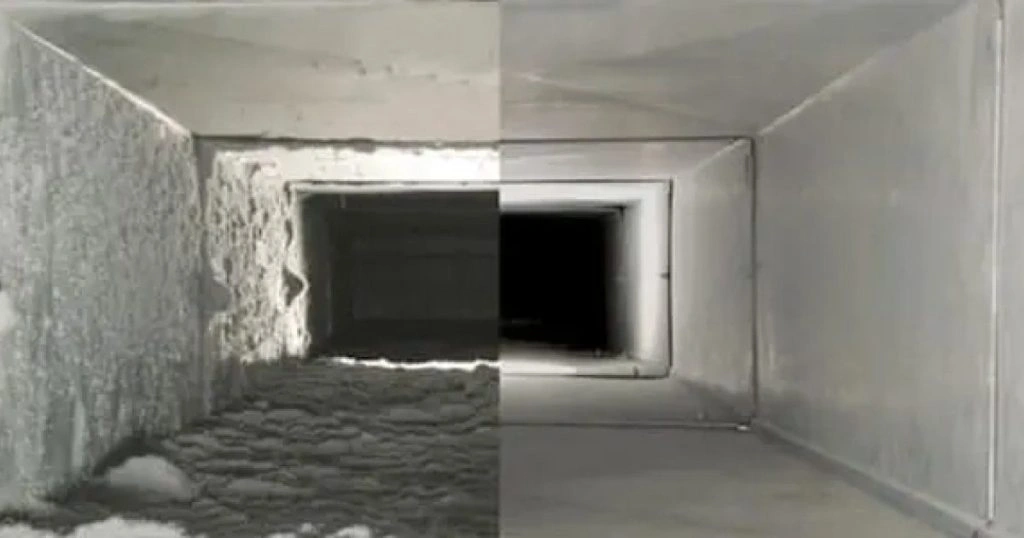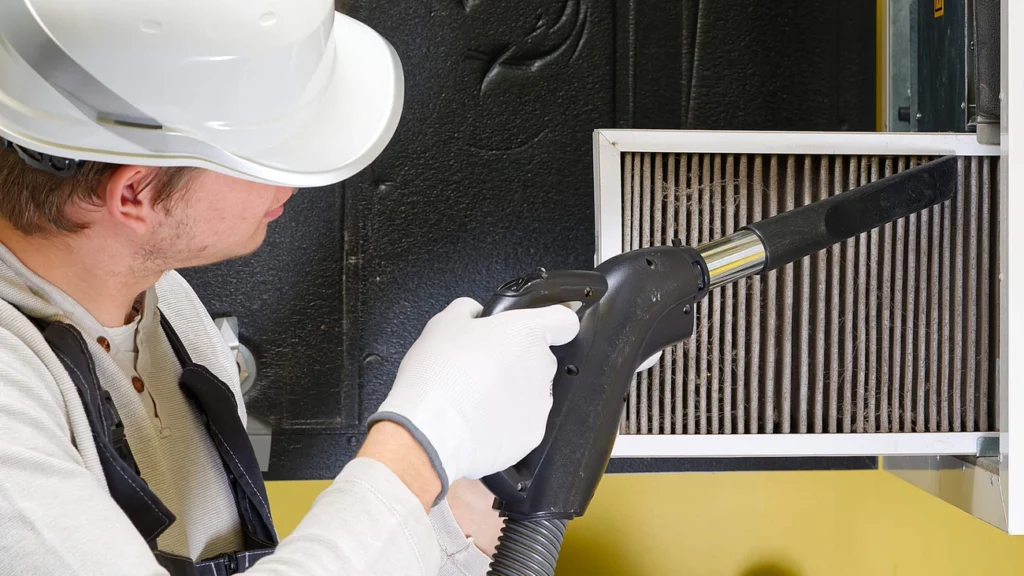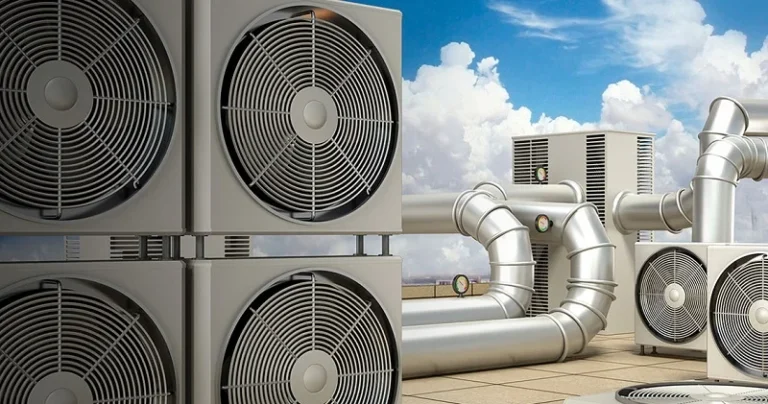Complete Guide to Residential Air Duct Cleaning: When, Why, and How

You’ve noticed that dusty smell every time your HVAC system kicks on, and no matter how often you clean, there’s still a fine layer of dust settling on your furniture within days. Maybe you’re dealing with unexplained allergies that seem worse at home, or your energy bills have been creeping higher despite no changes in your usage patterns. Your family might be experiencing more respiratory issues lately, and you’re starting to wonder if something in your home’s air system could be the culprit.
The good news is that professional air duct cleaning can address these exact issues by removing years of accumulated dust, debris, and contaminants from your home’s ventilation system. When done correctly, air duct cleaning improves indoor air quality, reduces allergens, and can even help your HVAC system run more efficiently.
This comprehensive guide will walk you through everything you need to know about residential air duct cleaning, from recognizing when it’s time for service to understanding what the process involves and how to choose the right professional.
What Is Air Duct Cleaning and Why Does It Matter?
Air duct cleaning is the process of removing dust, debris, and contaminants from your home’s heating, ventilation, and air conditioning (HVAC) system. This includes cleaning the supply and return air ducts, registers, grilles, diffusers, heat exchangers, heating and cooling coils, drip pans, fan motor, and the air handling unit housing. Over time, these components accumulate everything from household dust and pet dander to pollen and even mold spores.
Think of your air ducts as the lungs of your home. Every time your HVAC system runs, air circulates through these passages, picking up whatever has settled inside and distributing it throughout your living spaces. The Environmental Protection Agency (EPA) states that indoor air can be two to five times more polluted than outdoor air, and dirty air ducts contribute significantly to this problem.
Most homeowners don’t realize that their air ducts can harbor pounds of dust and debris. I’ve seen systems where the buildup was so severe that airflow was restricted by 40% or more, forcing the HVAC system to work harder and consume more energy. Clean air ducts not only improve air quality but can also extend the life of your HVAC equipment and reduce energy costs.
When Do You Need Air Duct Cleaning?
Visible Signs That Demand Immediate Attention
Excessive dust around your vents or on your furniture shortly after cleaning is often the first sign homeowners notice. If you’re seeing dust particles blowing out of your vents when the system starts up, or if there’s visible mold growth around your ductwork, these are clear indicators that cleaning is overdue. Dark streaks around your air vents, often called “ghosting,” occur when dust and debris create filtration patterns as air moves through dirty ducts.
Unusual odors from your vents can signal everything from accumulated pet dander to more serious issues like mold or even pest infestations. Musty, stale, or burning smells that persist after you’ve cleaned your home thoroughly often originate from contaminated ductwork. Trust your nose – if something doesn’t smell right when your HVAC system runs, it’s worth investigating.
Health and Comfort Indicators
Increased allergy symptoms or respiratory issues that seem worse at home can be directly linked to poor indoor air quality from dirty ducts. If family members are experiencing more frequent sneezing, coughing, or congestion indoors, contaminated air ducts might be circulating allergens throughout your home. This is particularly concerning for households with asthma sufferers or elderly family members who are more sensitive to air quality issues.
Uneven heating or cooling throughout your home can also indicate ductwork problems. When dust and debris accumulate in certain sections of your ductwork, they can restrict airflow to specific rooms, making your HVAC system work harder to maintain comfortable temperatures. You might notice some rooms are consistently warmer or cooler than others, despite your thermostat settings.
The Science Behind Air Duct Contamination
How Contaminants Enter Your System
Your HVAC system constantly pulls air from your home, filters it, conditions it, and redistributes it through your ductwork. During this process, particles that make it past your air filter – or bypass it entirely through leaks – settle inside your ducts. Common contaminants include household dust, cooking particles, cleaning product residues, pet dander, pollen from open windows, and even fibers from carpets and upholstery.
Construction or renovation activities can introduce significant amounts of debris into your ductwork. Drywall dust, sawdust, and other construction particles are particularly problematic because they’re fine enough to penetrate deep into your system but heavy enough to settle and accumulate. Many homeowners don’t realize that even minor home improvements can contaminate their entire duct system.
The Accumulation Process
Once contaminants enter your ductwork, they don’t just pass through – they stick around. Static electricity generated by air movement causes particles to cling to duct surfaces, while moisture from temperature changes can create the perfect environment for mold and bacteria growth. Over months and years, these layers build up, creating an ecosystem of dust, debris, and potentially harmful microorganisms.
Humidity levels play a crucial role in how quickly contamination occurs. Homes in humid climates or those with poor moisture control often experience faster buildup of mold and mildew in their ductwork. Even small amounts of moisture from cooking, showering, or laundry can create conditions that accelerate contamination in your air ducts.
Understanding the Professional Air Duct Cleaning Process

Pre-Cleaning Assessment and Preparation
Professional air duct cleaning begins with a thorough inspection of your entire HVAC system. Qualified technicians use cameras and other diagnostic tools to assess the extent of contamination and identify any potential issues like leaks, damaged ductwork, or pest infestations. This assessment helps determine the appropriate cleaning method and provides a baseline for measuring the effectiveness of the cleaning process.
Before cleaning begins, technicians should protect your home by covering furniture and flooring near work areas. Proper preparation includes sealing off sections of ductwork to prevent contamination from spreading to already-clean areas and ensuring that all access points are properly identified. Reputable companies will also verify that your HVAC system is in good working condition before beginning the cleaning process.
The Cleaning Equipment and Methods
Powerful vacuum systems are the backbone of professional air duct cleaning, typically truck-mounted units that create negative pressure throughout your ductwork. These systems can generate suction equivalent to several household vacuums combined, effectively removing loosened debris and contaminants. The vacuum system works in conjunction with specialized brushes, air whips, and compressed air tools that agitate and dislodge stubborn buildup from duct surfaces.
HEPA-filtered vacuum systems ensure that contaminants removed from your ducts don’t get released back into your home’s air. Professional-grade equipment includes various attachments designed for different duct shapes and sizes, allowing technicians to clean thoroughly without damaging your ductwork. Some companies also use antimicrobial treatments to address mold or bacteria concerns, though this should only be done with EPA-registered products.
What Gets Cleaned During Service
A comprehensive air duct cleaning service addresses all components of your HVAC system, not just the visible ductwork. This includes supply and return air ducts, air handling units, coils, drip pans, heat exchangers, and fan motors. Registers and grilles are removed, cleaned, and sanitized before being reinstalled.
Professional cleaning also includes replacing your air filter and checking for any damage or leaks that might compromise your system’s efficiency. Technicians should clean the blower compartment, which often accumulates significant debris, and ensure that all access panels are properly sealed after cleaning. A thorough service will leave your entire HVAC system clean and functioning optimally.
Choosing the Right Professional Service
Credentials and Certifications to Look For
NADCA (National Air Duct Cleaners Association) certification is the gold standard in the air duct cleaning industry. NADCA-certified companies must meet strict standards for equipment, procedures, and technician training. Look for companies that display current NADCA certification and can provide proof of their membership when asked.
Proper licensing and insurance are non-negotiable when choosing an air duct cleaning service. Verify that the company carries both general liability and workers’ compensation insurance to protect your property and their employees. Many states require specific licenses for HVAC work, so check your local requirements and ensure your chosen company complies with all regulations.
Red Flags to Avoid
Extremely low prices often indicate corner-cutting or bait-and-switch tactics. If a company offers whole-house air duct cleaning for significantly less than the industry average ($300-$500 for most homes), they’re likely using inferior equipment or planning to upsell you once they’re in your home. Legitimate companies invest in proper equipment and training, which is reflected in their pricing.
Door-to-door sales tactics or high-pressure sales calls are major warning signs. Reputable air duct cleaning companies typically don’t use these methods, as their reputation and referrals generate sufficient business. Be particularly wary of companies that claim to offer “free” inspections but then find expensive problems that require immediate attention.
The Investment: Understanding Air Duct Cleaning Costs
Factors That Influence Pricing
Home size and ductwork complexity are the primary factors determining air duct cleaning costs. A typical 2,000 square foot home with standard ductwork might cost $300-$500 to clean professionally, while larger homes or those with complex systems can cost $700-$1,000 or more. Additional factors include the number of vents, accessibility of ductwork, and the extent of contamination present.
Geographic location also impacts pricing, with services typically costing more in urban areas where overhead expenses are higher. The type of ductwork in your home matters too – flexible ducts are generally easier and less expensive to clean than hard-lined metal ducts with multiple bends and connections. Some companies charge per vent, while others offer flat rates based on square footage.
What You’re Actually Paying For
Professional equipment rental or ownership represents a significant portion of air duct cleaning costs. Truck-mounted vacuum systems can cost $50,000 or more, and companies must factor in equipment maintenance, fuel, and depreciation when setting prices. You’re also paying for specialized tools, HEPA filtration systems, and cleaning solutions that aren’t available to consumers.
Trained technician expertise and labor costs make up another substantial portion of the service fee. Proper air duct cleaning requires knowledge of HVAC systems, safety procedures, and cleaning techniques that take time to develop. Insurance, licensing, and continuing education requirements all contribute to the operational costs that are reflected in service pricing.
Maintaining Clean Air Ducts After Professional Service
Preventive Measures for Long-Term Results
Regular filter replacement is the single most important step you can take to maintain clean air ducts after professional cleaning. Check your air filter monthly and replace it at least every three months, or more frequently if you have pets or family members with allergies. High-quality filters capture more particles before they can enter your ductwork, significantly extending the time between professional cleanings.
Controlling moisture levels in your home prevents mold and mildew growth in your ductwork. Use exhaust fans in bathrooms and kitchens, repair leaks promptly, and maintain indoor humidity levels between 30-50%. Consider using a dehumidifier in humid climates or during wet seasons to prevent moisture-related contamination in your HVAC system.
Signs It’s Time for Another Cleaning
Most homes benefit from professional air duct cleaning every 3-5 years, but this timeline can vary based on factors like pets, smoking, recent construction, or family members with respiratory sensitivities. Keep an eye out for the return of dust around vents, unusual odors, or increased allergy symptoms that might indicate it’s time for another cleaning.
Document your cleaning date and any issues that were addressed during the service. This information helps you track the effectiveness of the cleaning and makes it easier to determine when your next service should be scheduled. Regular maintenance and attention to warning signs will help you get the maximum benefit from your investment in professional air duct cleaning.


